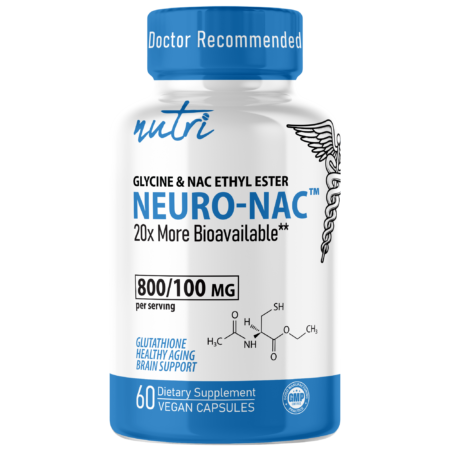NAC as a supplement has gotten a lot of hype over the years, and deservedly so. N-acetyl L-cysteine (NAC) is a popular form of the amino acid cysteine. Cysteine is critical for replenishing your glutathione (GSH) levels as they fall due to environmental toxins and age.
Glutathione is the mother of all antioxidants, and as such, it protects you oxidative stress and free radicals. One study on supplementation with Glycine and NAC to help correct a GSH deficiency in mice offered a 24% increase in lifespan.
As we age, our GSH levels begin a natural decline. Because glutathione is present in literally every cell of our body, falling levels have the potential to cause abnormalities in every bodily function and every cell.
As an effective glutathione booster, NAC is a hugely popular supplement. Unfortunately, NAC is going through some tough times. The FDA is fighting it as a supplement, and its bioavailability has room for improvement. But what could possibly be better than NAC?
Current Status
NAC is still a massive player in the supplementation industry. In 2021, it reached an incredible 300 million in global sales. With a projected 20% increase each year, it is estimated to reach a staggering 900 million by 2026. It is one of the top searches on Amazon and has a variety of uses.


Cysteine Supplementation
NAC is also very popular as a supplement. While NAC is highly effective within the liver and kidneys, it has a low bioavailability anywhere else. Extremely high doses of NAC are required to raise GSH within the cell, because it has poor membrane penetrability. Furthermore, NAC does not cross the blood-brain barrier. However, NAC still significantly increases plasma levels of glutathione, ranging from a 5-20% increase.
Problems
Unfortunately, stores are pulling NAC from their shelves left and right. This is in response to a pending FDA lawsuit against it in supplemental form. NAC was first patented in 1960, presumably as a supplement, 8 years before it was used medically. Sadly, that isn’t stopping the FDA from excluding NAC as a dietary supplement, citing the drug exclusion provision, signed in 1994, as an amendment to the Dietary Supplement Heath and Education Act.
The drug exclusion provision prohibits anything that was first used as a drug, or first researched as a new drug, from being included as a dietary supplement. There are two problems with this reasoning by the FDA. First, all evidence points to the fact that NAC was patented as a supplement long before it was used as a drug. Second, there are plenty of substances that coexist as both a supplement and a drug. Examples of this are caffeine and fish oil.
While industry leaders are fighting back, the future for NAC as a dietary supplement doesn’t look good. The FDA has a history of removing ingredients from the supplemental market even though their use predated pharmaceutical use. An example of this was the removal of vinpocetine in 2016. The next victim to the FDA support of pharmaceutical monopolies could very well be NAC. At the very least, it already has an undeserved dark shadow cast over it.
Another problem with NAC has nothing to do with governmental red tape, and everything to do with the effectiveness of the product itself. While it does raise GSH levels, it also has room for improvement. NAC is mostly metabolized in the liver and kidneys, leaving sparce amounts for the rest of the body. Where cysteine can offer the most benefit is in the plasma and increases there are negligible.
Solutions
NACET is another form of NAC that isn’t included in the lawsuit. Because it is structurally different, NACET is here to stay. Even better, NACET is superior to NAC in every way. While NAC has a bioavailability of 4-6%, NACET has a bioavailability of 60-80%. While NAC can increase plasma levels of GSH by a mere 5-20%, NACET increases plasma levels of GSH by a whopping 250%. Furthermore, NACET is esterified, which means that it can cross the blood brain barrier, allowing it to improve cognitive function and fight oxidative stress*. What’s more, NACET does all of that at a much lower dose than what is required for NAC to be effective.

Unfortunately, the days of NAC as a glutathione booster could be quickly coming to a close. Thankfully, an even better version is coming in on its tail. Everything that NAC could do, NACET does better—plus more.
-
$29.99 — or subscribe and save 15% Add to cart

